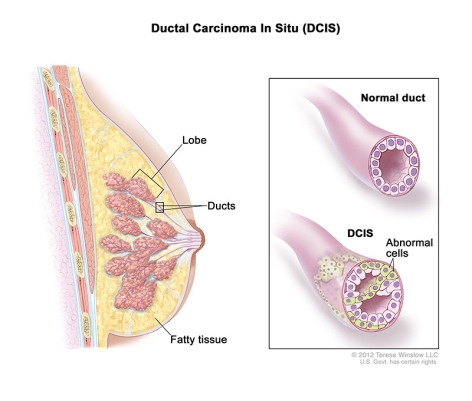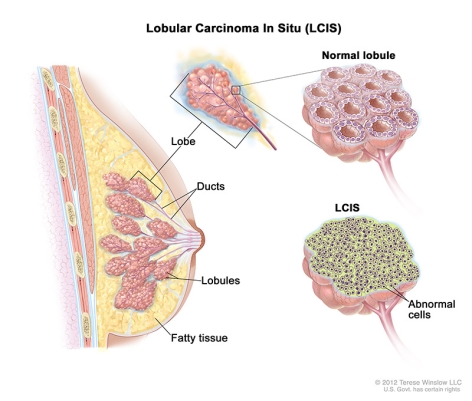Breast Cancer Types
Many people don’t realize how many types of breast cancer there are until they receive a breast cancer diagnosis. Or, how much their specific type of breast cancer affects their recommended treatment plan.
Before treatment begins, an in-depth evaluation will be done on the tumor removed during your breast cancer surgery or on the tissue that was collected from your breast biopsy. Several factors are looked at when determining breast cancer type, including:
-
The area of the breast where the cancer cells originated
-
How different the breast cancer cells look under the microscope compared to healthy cells
-
How the cancer cells react to hormones
-
The genetic makeup of the breast cancer cells
Breast Cancer is Either Non-Invasive or Invasive
Non-invasive breast cancer means that the cancerous cells are still confined to their point of origin, such as a breast duct. This might also be referred to as early-stage cancer. Many of these patients had their annual mammogram, which found a small area of cancer in the breast, which can be removed with only surgery and/or radiation in many cases.
Invasive (infiltrating) cancer means the cancer has spread outside of the area where it originally started. This can be other areas of the breast, the lymph nodes, or even other organs outside of the breast. These patients will typically require several treatments. The specific plan will be determined by other factors related to the type of breast cancer.
Types of Cancer Based on Where It Originated in the Breast
Most breast cancer starts in a milk duct. Others have it start in a lobule of the breast. The following categories are used to define not only whether it’s an invasive cancer but also where it started.
Ductal Carcinoma in Situ

Lobular Carcinoma in Situ

Invasive Ductal Carcinoma
Invasive ductal carcinoma or infiltrating ductal carcinoma (IDC) means that abnormal cells that originated in the lining of the breast milk duct have invaded surrounding tissue. Over time, IDC can spread to the lymph nodes and possibly to other areas of the body. IDC is the most common type of breast cancer, accounting for approximately 80% of all breast cancers.
Invasive Lobular Carcinoma
Invasive lobular carcinoma (ILC) starts in the milk-producing glands (lobules) and can spread to other parts of the body. Invasive lobular carcinoma is the second most common form of invasive breast cancer, accounting for 10 to 15% of breast cancer cases.
Inflammatory Breast Cancer
Inflammatory breast cancer (IBC) is an aggressive type of invasive cancer that accounts for about 1% to 5% of all breast cancers. IBC often appears like an infection (breast red, swollen and inflamed) but it is actually cancer that is blocking lymphatic vessels in the skin and breast tissue, causing a build up of fluid (lymph).
Hormone Receptor Status for Breast Cancer
Breast cancer treatment plans are often personalized based on your specific type and stage of breast cancer. Your oncologist will also need to know which hormones, if any, are involved in the growth of breast cancer.
The hormone receptor status of breast cancer refers to whether the breast cancer cells are fueled by estrogen and/or progesterone due to special proteins inside the tumor cells called hormone receptors. When hormones attach to hormone receptors, the cancer cells grow.
A hormone receptor status is either hormone receptor (HR) positive or hormone receptor (HR) negative.
-
Hormone receptor-positive breast cancer cells have either estrogen (ER) or progesterone (PR) receptors. Hormone therapy drugs are often used for these breast cancers to help lower estrogen levels or block estrogen receptors. HR-positive cancers tend to grow more slowly than those that are HR-negative. HR-positive cancers are generally more common in women after menopause.
-
Hormone receptor-negative breast cancers do not have estrogen or progesterone receptors. These types of cancers will not benefit from hormone therapy drugs and typically grow faster than HR-positive cancers. HR-negative cancers are more common in women who have not yet gone through menopause.
If the cancer is hormone receptor-positive, hormone therapy is likely to be included in the treatment plan to help suppress the hormones that are fueling the cancer’s growth.
HER2 Status in Breast Cancer
Some genes and the proteins they make can influence how the breast cancer behaves and how it may respond to a specific cancer treatment. One such gene that can play a role in the development of breast cancer is human epidermal growth factor receptor 2, or HER2 for short.
HER2 receptors typically help control how a healthy breast cell grows, divides, and repairs itself. However, if the HER2 gene doesn’t work correctly and duplicates itself too much, it leads to uncontrolled growth of breast cancer cells.
What does it mean to be HER2- negative or positive?
Breast cancers that have abnormally high levels of HER2 proteins are called HER2-positive, while breast cancers that don’t are called HER2-negative. While HER2-positive breast cancer grows and spreads more quickly than HER2-negative breast cancer, it isn’t nearly as common.
The common treatment for HER2-positive breast cancers typically includes targeted therapy drugs that slow the growth and kill these cancer cells. Tumors that are HER2-negative will not respond to therapies that specifically target HER2 receptors.
Triple-Negative Breast Cancer
Triple-negative breast cancer is a type of breast cancer that has no estrogen receptors, progesterone receptors, or HER2 receptors.
Because triple-negative breast cancer doesn’t show hormone receptors on cancer cells, it’s unlikely to be responsive to breast cancer treatments using hormone blockers to slow the growth of estrogen-positive or progesterone-positive cancers. Targeted therapies for HER2 protein are ineffective as well since there is no significant amount of HER2 protein fueling the cancer.
Triple-negative breast cancer is typically treated with a combination of treatments that may include surgery, radiation therapy, chemotherapy, and, in some cases, immunotherapy. Other combination therapies continued to be studied by researchers. If you have been diagnosed with triple-negative breast cancer, you may be offered a clinical trial as part of this significant research effort to find a widely accepted treatment plan.
Triple-Positive Breast Cancer
Triple-negative cancer means that your breast cancer cells test positive for estrogen receptors, progesterone receptors, and HER2. These cancers can be treated with hormone drugs as well as drugs that target HER2. For these patients, hormone therapy and targeted therapy may be included in addition to surgery and other therapies.
Treatment is Based on the Type(s) of Breast Cancer
Your breast cancer oncologist will review your test results, images, and pathology reports to develop a personalized treatment plan. They will also consult with other members of the cancer care team, including the surgeon and radiation oncologist.
Based on the team’s coordination, a plan that is most likely to work best for you will be presented and explained. Treatments can include one or more of the following:
- Radiation therapy
- Chemotherapy
- Hormone therapy
- Immunotherapy
- Targeted therapy
- Surgery
Learn more about treatments specific to breast cancer.
Find Breast Cancer Care and the Latest Treatments in Winchester, Virginia
The breast cancer specialists at Shenandoah Oncology work with you to ensure you have the most effective breast cancer treatment plan. We are located in Winchester, Virginia, and offer cancer care for patients across the Shenandoah Valley, Northern Virginia, West Virginia, and Western Maryland. We also offer second opinions on diagnosis and treatment plans for breast cancer. Contact us today to schedule an appointment.

 Learn More
Learn More